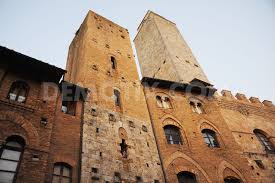- Attached to the essay "Misguided"
What does Wikipedia have to say on the purpose of the towers?
Posted December 9, 2013 9:50 pmNot very much. The site mentions that the Guelphs and Ghibellines conflict and family rivalries “resulted in families building tower houses of increasing height…. The rivalry was finally restrained when it was ordained by the council that no tower was to be taller than that adjacent to the Palazzo Comunale [the town hall].” Wikipedia is suggesting that the towers had no purpose other than one-upmanship. Could that have been true? 
The town’s own website offers a bit more of an explanation, though the English translation is not entirely successful:
“The first towers rose wide apart in a rarefied urban fabric looking very different from the nowadays compact centre. Towers were used in a different way. Rooms were very narrow, generally 1x2m; there were a few openings, and the walls, about 2m thick, assured cool temperature in summer and hot in winter. Almost all the towers were built next to other buildings in perishable materials such as wood and earth. In medieval times the tower was the higher symbol of power, mainly because the building process was not simple or cheap at all. Materials needed to be dug and transferred to town, and the building site arranged. Only the richest families of merchants and moneylenders could afford the works of construction.
The house occupied just part of the tower. The ground floor consisted of workshops, the first floor of bedrooms, and the higher level of the kitchen. The destination of each room followed the simplest security rules. The kitchen, where a fire was usually lighted, was located on the highest live-in room, to escape in case of accidental fire.
During the twelfth century the changes in the buildings were mainly directed to improve the daily life. The need of larger inside spaces and of wider openings brought to new building models, which mainly involved the towers.
The reference model for the towers built between the first half of the twelfth century and the first half of the thirteenth century is the so-called Pisa model, exported from the famous Tuscan maritime town. According to this style, buildings had one or more high and narrow openings on lower levels, which cross the tower from side to side. The openings that stretched for several levels were shared inside by wooden floors, which corresponded to outside full-wide wooden balconies. With these balconies inner spaces were expanded outside the walls of the buildings.”
Apparently, the towers began as adjunct buildings that were later incorporated into the adjacent houses themselves. Subjected to enlargement and alteration over the centuries, the towers changed enough that their original appearance is not easily determined. Did they in fact have exterior balconies? They must have had interior floors and stairs, though there seems to be no agreement about that, either. Most of the internet information reiterates the notion that they served no purpose other than to show off the wealth and power of the aristocracy that could afford to build them, but as each site is copying the next, there is no additional information to support the argument. Strange.
share
 site feed
site feed


